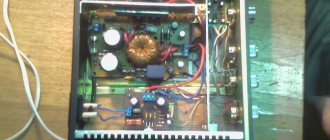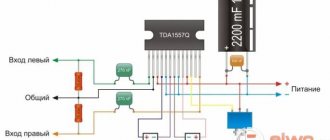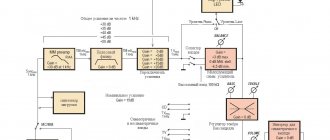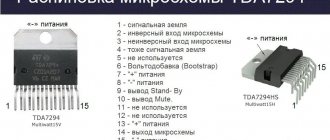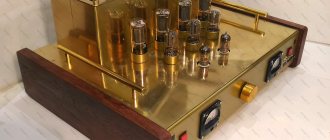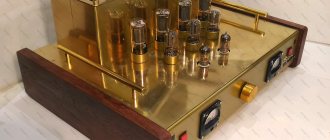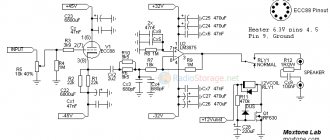Don't dream, act!
An unforgettable shot from an unforgettable film.
Now Marty McFly will fry!!! This part of the project invites the reader to test an effective way to achieve high-quality sound reproduction by converting a traditional VCS (Voltage Controlled Current Source) to a Voltage Controlled Current Source (VCS). An approach based on combined current and voltage negative feedback is also mentioned.
↑ Experiments with ITUN
With a slight movement of the soldering iron, Peter Smith's amplifier turns into a voltage-controlled current source - ITUN (Fig. 1). Additional installed elements are outlined in the figure with a dotted line. Be sure to check out this technical solution.
It should, however, be taken into account that the acoustic system (AS) must be broadband (single-way or two-way speakers with simple filters no higher than first order). My acoustic system was four-watt speakers made from an open box from a portable electrophone. The sensitivity of the amplifier from the input is about 0.5 V.
Fragment excluded. The full version is available to patrons and full members of the community.
Current control of loudspeakers shows a number of advantages compared to amplifiers with low output impedance [1 - 6]:
• Nonlinear and intermodulation distortions are significantly reduced; • The unevenness of the frequency response is reduced and the band of reproducible frequencies is expanded; • The impulse response of the loudspeaker is improved. • The intelligibility of phonograms is significantly improved, which is important for people with hearing loss.
Impressed by this experiment, the reader will ask a number of questions: “Where is the audio industry looking? Why has such a significant improvement in sound reproduction quality from the use of current amplifiers not yet been noticed? Is it really difficult to create serial audio amplifiers with current output?”
However, the question is not in creating serial samples of current amplifiers, but in matching them with acoustic systems. The latter are designed for low output impedance of amplifiers (powered from a voltage source), while ensuring the correct tonal balance and flat frequency response.
Attempting to connect an ITUN (current generator) to a multi-way speaker system will result in a tonal balance failure, negating the distortion reduction. In addition, significant problems are observed near the resonant frequencies of the dynamic drivers, where the impedance modulus begins to increase. Since the voltage at the output of the current amplifier is proportional to the load resistance, the voltage at the head also increases, which leads to overload with a sharp deterioration in sound reproduction quality.
Therefore, a change in the design methodology for multi-band speakers designed for current control is required.
And yet, to such an extent, a noticeable improvement in sound quality in such an accessible way cannot go unnoticed (at least by radio amateurs). Amplifiers with current feedback can be successfully used as bandpass amplifiers when designing active speaker systems with an active crossover (multi-band crossover filter in front of bandpass UMZCH).
In article [2], Sergei Ageev hoped to please the amateur public with the design of a high-quality four-way loudspeaker based on common dynamic drivers, built on the basis of the distortion reduction principles he proposed. But as the famous proverb says, “If you want to make God laugh, set your plans!” I have repeatedly been convinced of its justice from my own experience.
ASP Optimus Classic SB II
Dimensions: height - 1070 mm, width (base) - 283 mm, depth (base) - 366 mm;
Single column weight: 37 kg; Type: three-way with bass reflex. Bass reflex - front; Frequency band: 32–30000 Hz, with unevenness -3 dB; Nominal resistance: 8 ohms; Sensitivity: 89 dB; Speakers from SB Acoustics' top line Satori were used: TW29R-B, MR16P-4, SB23NRXS45-8; The filters use top-end components from Jantzen and Mundorf; Grills made of sound-transparent Jantzen fabric - included; Spikes - included; Veneer material is your choice (I chose light oak). The acoustics are well made, and their appearance is very beautiful. If you don’t know that this is an original work, you might think that this is a famous brand. True, handmade is still felt. In veneer joints, for example. But this only emphasizes the individuality of each product.
The warming continued for one month, 2–3 hours a day. After a month, I stopped hearing changes in the tonal balance in the sound of the acoustics.
↑ Combined current and voltage feedback
The approach based on the use of combined negative current and voltage feedback, which makes it possible to build amplifiers with non-zero output impedance [5, 7 - 9], significantly expands the field of activity of amateurs.
Wherein:
• The operating conditions of the loudspeaker head are improved and its nonlinear distortions are reduced; • The electrical and overall quality factor of the low-frequency loudspeaker increases, which changes its frequency response in the low-frequency region.
Combined voltage and current feedback effectively reduces transient intermodulation distortion, improves audio attack fidelity, and provides
Perhaps
the greatest effect is in improving the quality of sound reproduction
.
From a practical point of view, we should highlight the publications of our fellow citizen Igor Rogov [7, 8], which consider circuits for constructing UMZCH with non-zero output resistance for inverting and non-inverting amplifiers.
A calculation program has also been developed, supplemented by an example of assessing the frequency response of a loudspeaker in a “closed box” acoustic design when connecting it to the specified amplifier [8].
Shown in Fig. Circuit 1 is not a “pure” voltage-to-current converter (VTC), but an amplifier with combined negative feedback for current and voltage. Its peculiarity is that it allows you to obtain the required output impedance of the amplifier.
The output resistance is adjusted by changing the resistance of resistor R8. The required output impedance will help you choose the table. 1. Please note that the output resistance Rout does not depend on the load resistance (AC). Only the gain of the amplifier changes.
As can be seen from table. 1, the output impedance of the amplifier can vary over a fairly wide range, allowing you to find the optimal sound quality. Typically it corresponds to an output impedance commensurate with the load impedance. Here the ratio Rн/R9=R5/R4 is made so that the gain does not depend on the value of R8.
It is possible to calculate the parameters of the UMZCH feedback circuits in such a way that the amplifier transmission coefficient (Ku = 25.2 dB) is constant for load resistance Rн = 4; 6 and 8 Ohm. In this case, the output resistance Rout for each Rн will be determined by its value R8 (Table 2).
I strongly advise you to get acquainted with this interesting side of the interaction between UMZCH and AS in practice. It is quite possible to abandon the circuit R4, C3, which, however, will lead to a change in the gain of the UMZCH when setting the required output resistance of the amplifier with resistor R8.
The necessary information for the experiments is shown in Fig. 2 and in table. 3.
Fragment excluded. The full version is available to patrons and full members of the community.
When R4 is more than 1 kOhm, the capacitance of capacitor C3 can be reduced to 100 μF.
Best Portable Amplifiers (Headphones)
Cheap Chinese headphones will not sound any better thanks to these devices, but in combination with good models, portable amplifiers will help you fine-tune the sound more precisely and “swing” your ears to the fullest.
McIntosh MHA50
5
★★★★★
editorial assessment
98%
buyers recommend this product
Quite a large and by no means the most affordable amplifier from an American company that produces high-end equipment. The device is not comparable in compactness to budget models - it is even larger in size than modern smartphones. But the device produces sound of an unattainable level (and this despite the lack of support for the aptX HD codec). The 3000 mAh battery provides up to 6 hours of operation.
Advantages:
- Impeccable sound quality;
- Nice design;
- Good equipment;
- Several connectors for connecting to different sound sources;
- Supports headphones with impedance from 8 to 600 Ohms.
Flaws:
- High price;
- Large dimensions.
This is a unique device that will interest people who truly live for music. The amplifier provides amazing sound regardless of the source and quality of headphones. However, this is not without its drawbacks: price, size and mediocre autonomy.
FiiO BTR3
4.9
★★★★★
editorial assessment
92%
buyers recommend this product
FiiO is one of the most popular manufacturers with a huge range of devices for audiophiles. The BTR3 is the most notable of the brand's new models. Its design is quite simple: an ordinary glossy box. But there is an interesting solution in the form of changing the backlight depending on the selected codec. The body contains controls in the form of physical buttons. The device operates for about 10-11 hours on a single charge.
Headphones are connected to the amplifier by wire, and the BTR3 itself is paired with a smartphone via Bluetooth. It reproduces frequencies in the range from 20 to 40,000 Hz, connects via Bluetooth 4.2 and supports all current codecs: aptX, aptX HD, AAC, LDAC and others. There is also an application for basic setup, and using the USB-C connector the device can be connected, for example, to a laptop.
Advantages:
- Excellent sound quality;
- Supports all current codecs;
- Good autonomy;
- Minimalistic design;
- Color coding of codecs;
- USB-C connector.
Flaws:
- Small controls;
- Not a very high quality microphone.
The device, which looks like MP3 players of the last century, provides the highest quality sound from almost any headphones and works with all modern codecs.
Beyerdynamic Impacto Universal
4.8
★★★★★
editorial assessment
87%
buyers recommend this product
A small headphone amplifier shaped like a thick player, it works with both Android smartphones and iPhones. You can also connect to a PC. Impacto Universal plays Hi-Res audio files up to 32-bit/384 kHz. Frequency range: 4 - 52,000 Hz. Without cable and battery, the accessory weighs only 12 g.
Advantages:
- Compact and lightweight;
- Great sound;
- Several connectors for different devices;
- Nice design.
Flaws:
- The price is a bit high;
- Not very rich equipment.
An expensive but high-quality headphone amplifier is primarily intended for models from the same manufacturer.
↑ Disadvantages of ITUN and amplifiers with adjustable output impedance
I see two main disadvantages:
1. Amplifiers with current output and adjustable output impedance are not universal and are very sensitive to acoustic systems. On a number of speakers, an increase in output impedance does not lead to an improvement in sound quality; some speakers begin to “mumble.”
2. As the input signal level increases, intermodulation distortion at low frequencies grows faster compared to powering the speakers from a voltage source. This effect is caused by a decrease in magnetic induction in the extreme positions of the speaker cone. Since in ITUN and amplifiers with adjustable output impedance, the force from the coil is directly proportional to the current strength and magnetic induction in the coil gap, a decrease in induction leads to the appearance of harmonics (mainly the second and third). In amplifiers powered by a voltage source, the current in the coil depends on its ohmic resistance and inductance, the negative influence of which is minimized in modern dynamic drivers.
Nutrition
The apartment building where I live is relatively new - built in 1999. Power supply is good. All wiring in the apartment has been replaced with copper 2.5 mm². A separate wire from the panel goes to the sockets to which the amplifier and other audio equipment are connected. The amplifier is connected by an ordinary power cable with a cross-section of 0.75 mm², from a Hewlett-Packard laser printer. An attempt to replace this power cable with a thick Chinese one (16 mm thick, core cross-section 4 mm²) costing 2,000 rubles ended in failure - the sound deteriorated. The detail and volume are gone.
↑ Further action plan
Urging the reader to plunge into a series of interesting experiments with current amplifiers and with combined feedback (current and voltage), I want to offer two designs that use ITUN, but in general the UMZCH has the traditional properties of low output resistance, that is, it is designed to work with commercially produced acoustic systems.
The first of the proposed schemes
is described in part
5-4
and contains a voltage-to-current converter in the output stage, and in general the UMZCH is covered by a deep OOS in terms of voltage.
In the second UMZCH
The ITUN is located at the input of the output stage, covered by a parallel OOS, which made it possible to ensure its maximum depth. This scheme is described in the final part
5-5
.
The picture in the article's abstract shows an example of competent loudspeaker control. A scene from the first part of the sci-fi trilogy, Back to the Future, in which Marty McFly tries to play his guitar by connecting it to a huge speaker in Doc Brown's laboratory.
Audition 1
Source - Marantz CD-48 CD player, a coaxial output is used, connected by a coaxial cable (an ordinary Chinese cord, costing 1,400 rubles per pair) to the SMSL M400 DAC (using the latest AK4499 chip), which is connected to the balanced input of the PAS-240 amplifier via Chinese balanced cable, 50 cm long and costing 2,200 rubles per pair. For listening, I chose a CD of BG and Aquarium of a rather rare edition (circulation of 2,000 copies), which was released by OCS in 2003.
The song “Kostroma Mon Amour” (gain control at 11 o’clock) sounds shrill. Grebenshchikov's voice is recognizable and languid, with characteristic intonations due to its crystal clear sound and is perceived not as a show off, but as a restrained confession. The bass line is defined, precise and superb.
The accompaniment is unobtrusive. The stage is wide, the voice protrudes slightly forward. Good job by the sound engineer. I had a lot of fun. Well, some experiment: I connected the DAC to the unbalanced input of the amplifier. Decent. But that highest level of detail and transparency was gone.
↑ Sources mentioned
1. Page of Nikolai Lishmanov (Lincor) 2. Ageev S. Should the UMZCH have a low output resistance? (On reducing intermodulation distortion and overtones in loudspeakers) // Radio, 1997, No. 4, p. 14 – 16. 3. Aleinov A., Syritso A. Improving sound reproduction in the UMZCH - loudspeaker system // Radio, 2000, No. 7, p. 16 – 18. 4. UMZCH with current output. Principle of operation and practical circuits 5. Audio amplifier MF-1 on TDA7294/93 with hybrid OOS 6. Sapozhnikov M. Non-standard inclusions of microcircuits in UMZCH // Radio, 1998, No. 2 p. 23. 7. Rogov I. Adjustment of the output resistance of the UMZCH through a combined OOS // Radio, 2007, No. 10, p. 19 – 22. 8. Program for calculating combined environmental protection 9. Rogov I. UMZCH with adjustable output resistance // Radio, 2008, No. 4, p. 14 – 17; 2008, No. 5, p. 14, 15.
Audition 2
The source is a portable player Cayin i5 (using AK4490), the linear output of which is connected to the unbalanced input of the amplifier using a Supra BiLine -MP cable (mini-jack 3.5 mm - 2xRCA, price 4,740 rubles).
“Dance of the Buffoons” (from the opera “The Snow Maiden” by N.A. Rimsky-Korsakov) performed by the Minnesota Orchestra (conductor Eiji Oue, Tutti disc, reference recording, FLAC). Volume control at 11 o'clock. Full presence in front of the sounding orchestra. From barely audible piano to thunderous, chest-thumping, fortissimo timpani and brass cymbals! Delight!
And all this sounds, without mixing into mush, transparently and in detail. The amplifier and speakers cope well with the explosive nature of the piece. Great performance, great recording, great playback!
▍ From the author
This series of publications consists of six parts. Brief contents of publications:
- Prerequisites for the emergence of op-amps. The "ideal" operational amplifier. Inverting and non-inverting amplifiers, repeater. <—You are here
- Differences between a “real” op-amp and an “ideal” one. Main characteristics of a real op-amp. Limitations of a real op-amp.
- Summing amplifier. Difference amplifier. Instrumentation amplifier. Integrating link. Differentiating link. Sample-hold scheme.
- Active detector. Active peak detector. Logarithmic amplifier. Active signal limiter. Op-amp comparator. Reference voltage source. Current source. Amplifier.
- Frequency-dependent feedback in an op-amp. Active filters on op-amp. Signal generators based on op-amps.
- Unipolar connection of the op-amp. Input noise, decoupling and protection of input circuits, shielding.
Used sources:
- Gutnikov. Integrated electronics in measuring devices. Energoatomizdat, 1988
- Horowitz, Hill. The art of circuit design. 2nd ed. World, 1993
- Tietze, Schenk. Semiconductor circuitry. 5th ed. World, 1982
- Shkritek. Audio Circuitry Reference Guide. World, 1991


